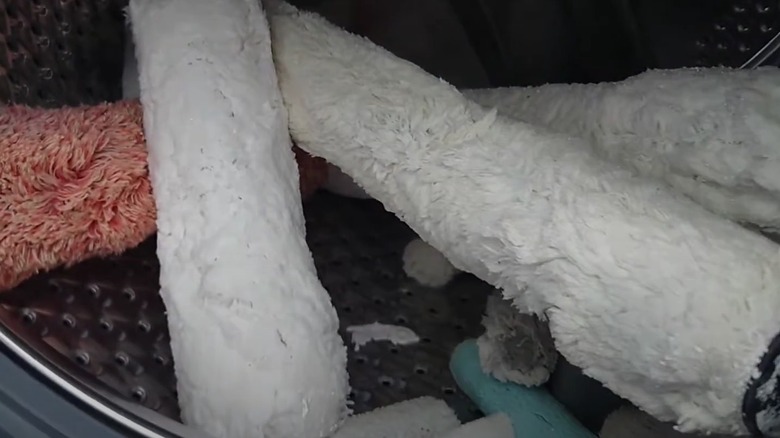Think Twice Before Throwing Your Paint Roller Covers In The Washing Machine
Painting a large space like a wall or a ceiling often goes faster when you make use of a paint roller cover rather than a brush. The roller cover is the cylindrical piece covered in an absorbent fabric that you slide over the handle on the tool. Finding just the right roller for your painting project, based on the surface on which you're working, gives you the results you are seeking.
But can you reuse this tool? And how do you clean it? You may have heard that you can place it in a washing machine to clean the paint out of it so that it's ready for the next time you need to use it. Although you may be leery of cleaning it this way, it does work. However, you need to weigh the pros and cons before you decide to use this method of cleaning it.
First, make sure the cylindrical paint roller cover is in good shape. An older cover that has loose fabrics or is fraying is not going to do well inside the machine. If you purchased a cheap roller, though, you probably expected to throw it away afterward anyway, so you may not care if machine washing ruins the fabric.
If you plan to use this technique, look for a paint roller cover that says it is machine washable when you are shopping for this product. Some higher-priced models will mention this type of cleaning option as being safe on the product wrapper.
Dangers of machine washing paint roller covers that you'll want to avoid
As you might imagine, choosing to wash your paint roller in the washing machine does have some potential drawbacks. The biggest potential problem is that the process could damage the washing machine, which is an expensive appliance that costs quite a bit to get fixed, so you may not want to risk damaging it.
The paint that you are trying to clean out of the roller covers could have chemicals and other solvents in it that cause damage to components in the machine, especially those made of plastic, leaving it inoperable. If residual paint off the rollers finds its way into a crevice of the machine, you might not see it. It then could pop loose when you are washing clothes later, staining and ruining them.
There's also a possibility of causing damage to the paint roller covers themselves. The fibers on the fabric may suffer deterioration faster with this type of cleaning than if you clean them by hand in a utility sink or bathtub.
Finally, there's also the use of energy and water when running the washing machine for this process. If you only have one or two paint roller covers to clean, running a full cycle may not be the best use of your resources, potentially driving up your utility bill. Should you have a large number of these to clean at once, though, it may be worth running them through a cleaning cycle.
Steps to take to wash your paint roller covers in the washing machine
If you want to try machine washing your paint roller covers, start by removing as much excess paint from the fabric of the roller as possible. Use a putty knife to scrape wet paint away from the fabric and back into the can. Or use your hand to move down the fabric as you squeeze the roller while holding it over the can. Wear rubber gloves to protect your skin during this process.
Then, pull the cylinder off the handle, as you don't want to place the handle in the washing machine. Place all the paint roller covers you want to clean into the washing machine and close the door or lid. Use a cold water setting and a delicate cycle to clean them. Do not dry them with heat in the machine. Instead, take them outdoors and hang them on a clothesline to allow them to air dry.
We also should mention that if you plan to use the roller covers again in the next few days to add another coat or to do additional paint work, you don't have to clean them yet. Instead, keep the paint roller from drying out overnight by wrapping it tightly inside plastic and storing it in a cool place. By reusing the covers this way, you can wait to run all of them through the washing machine until you are completely finished using them.


